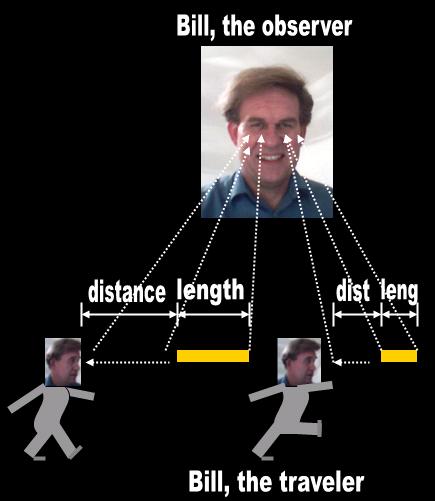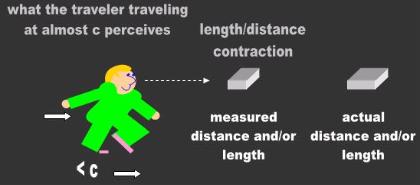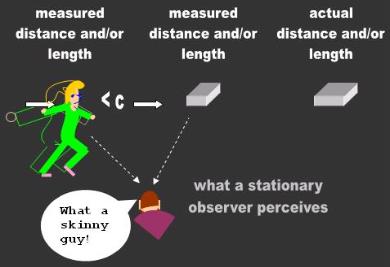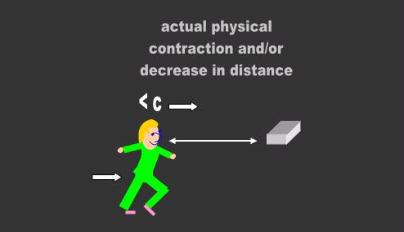| Adapted for the Internet from: Why God Doesn't Exist |
| None of the three length contraction versions of relativity is rational |
- One serious shortcoming of the length-contraction theory is that relativists draw three different conclusions from the equation.
Some believe that the traveler notices no changes in his vicinity while others predict that he will. Others believe that a stationary
observer will notice changes of far away objects. Yet others believe that the contraction is not just an issue of measurement and
perceptions, but that it is a real phenomenon (Fig. 1).
a. The traveler has trouble measuring lengths and distances in his direction of motion:
- “ an observer travelling at the speed of light …would measure all distances
in the direction of motion as 0.” [1]
“ An observer in motion relative to an object measures the length of that object
along the direction of motion to be contracted when compared to the length
measured by an observer at rest relative to the object.” [2]
“ An observer moving with respect to an object will observe it to be contracted
along the direction of motion.” [3]
- Although lengths and distances shrink in the direction of motion, for odd reasons, the distance from the traveler’s face to the end
of his nose (i.e., the length of his nose) seems to suffer no change:
- “ An observer moving with the velocity, v, of the stick will discover, however, that in his frame
of reference, the stick, at rest, still has the length Lo.” [4]
- b. A stationary observer sees and measures that the traveler and his ruler are flatter when they move orthogonally with respect
to his line of sight:
- “ the source of light and the mirror draw closer together when the system is moving
lengthwise.” [5]
“ Let us consider a stick, which, at rest, has the length Lo, moving with respect to a
stationary observer with the velocity v parallel to its length. The stationary observer will
discover that, in his frame of reference, the stick has suffered a contraction.” [6]
“ When an object (with mass) is in motion, its measured length shrinks in the direction of its
motion. If the object reaches the speed of light, its measured length shrinks to nothing.
Only a person that is in a different frame of reference from the object would be able to
detect the shrinking - as far as the object is concerned, in its frame of reference, its size
remains the same.”[7]
- c. The traveler and everything around him actually (physically) shrink:
“ This transformation represents an actual change in the dimensions of length and of time,
not just a shortening of rulers or a slowing of clocks, and not just a visual effect.” [8]
“ These effects are not merely appearances” [9]
[ So Bill? Why do you say that the mathematicians of the world are a bunch of stupid
morons?]
Fig. 1 The three physical interpretations relativists give to the Lorentz Fitzgerald equation |


| I didn't see any contraction |
< The traveler measures shorter lengths and/or distances, allegedly in his direction of travel. It is important to note that we can only measure lengths sideways. Therefore, the question is, how does the traveler certify that length contracted ‘in his direction of travel’? < A stationary observer measures shorter lengths and/or distances of speeding objects. The observer is measuring lengths and distances per- pendicularly to the traveler’s direction of travel. An observer may at best enjoy a side view. Objects and/or distances actually flatten in the direc-tion of travel irrespective of measurements or observers. |



So which of these explanations is consistent with the equations? How does impeccable math result in such divergent physical
interpretations? Or is it that quantities have no authority to tell us anything about Physics?
- Module main page: Relativists don't understand the difference between distance and distance-traveled
Pages in this module:
- 1. What do relativists mean by length contraction?
2. My ruler can contract, but not its length!
3. This page: None of the three length contraction versions of relativity are rational
- a. Contraction from the traveler's perspective:
Relativists say that a speeding muon draws two mountains together
- b. Contraction from the observer's perspective:
SR contradicts GR
c. Real contraction:
We don't prove contraction with equations or experiments
- ________________________________________________________________________________________
- Copyright © by Nila Gaede 2008
